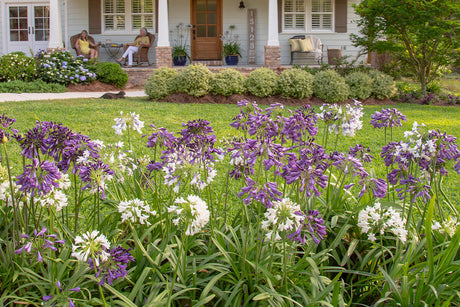

Liriope Buyer's Guide
|
|
Time to read 3 min
|
|
Time to read 3 min
Liriope, also known as Monkey Grass, is an easy-growing perennial grass you can plant along walkways, pathways, and flower borders throughout any landscape. Liriope, dubbed Lillie turf, is drought-resistant, deer-proof, and withstands many climates from a growing zone 4 to 10. In the summer, it produces lavender flower spikes with hues of purple or pink that compliment the grass-like foliage.
The majority of Liriope grow between 10 to 18 inches tall. Liriope Muscari grows in a clumping habit that reaches about 8 to 15 inches wide, depending on the variety you choose. You can space these 8 inches apart to create a dense border, mass planting, or foundation plantings. If you space them 15+ inches apart, you can see their weeping habits better.
Liriope is used as ground cover along sidewalks and pathways or around trees and shrubs. In addition, people often use them in mass plantings on slopes or along streams to provide a contrasting texture. Liriope can be grown in full sun to part shade. It can also be planted in various soils and does well in drought. Liriope’s hardiness makes it a versatile groundcover that will space quickly and provide lasting beauty.
The plants are evergreen in warmer weather and prefer mild winter weather. In colder USDA Zones, Liriope dies in the late autumn and is used more like an annual. Lilyturf is very hardy and low maintenance.
Liriope require very little fertilization, but you can fertilize them after spring growth begins with a granular slow-release, balanced fertilizer or organic plant food. We use Osmacote Slow-Release fertilizer on our plants in mid to early spring.
Once fall arrives, you can cut back the leaves and dead foliage of your liriope. Use shears or even a weed eater to make the process quick. If you live in warmer climates where the plant will stay evergreen, the plant will recover quickly. If you live in an area where the plant goes dormant, expect the foliage to start emerging in early spring.
Once established, monkey grass is drought tolerant. In the first season after planting, they need regular water. Liriope prefers soil that is consistently moist but not soaked. Over watering can lead to root rot and then potentially crown rot. Well-drained soil is preferred, but they can tolerate clay or sandy soils. Adjust your watering to how well your soil drains in your garden.
Plant your liriope in full sun to part shade. They prefer morning sun and afternoon shade, but are tolerable of a variety of conditions. Avoid deep shade areas that get no direct sunlight during the day.
Plants by Mail offers two sizes of Liriope in most varieties, a 2.5 Quart and an 18-pack of 3-inch cups. The 2.5 Quart plant will be close to the fully mature size of the monkey grass. These are great options for filling in an existing bed or replacing a dead or deteriorated plant. The 18-pack liner trays have plants with much smaller root systems and plant growth. These are ideal for starting your mass plantings. However, they are similar to grass plugs and will take several years to mature into an ideal ground cover.
Variegated Liriope grass has leaves with green stripes and vertical creamy-white borders on their leaf margins. They produce spikes of lavender flowers above the grassy clumps in the summer. Unlike other liriope spicata that spread everywhere, these Variegated liriope varieties keep tight clumping habits that require little maintenance.
Hardy in USDA Zones 6-10.
Aztec Grass has eye-catching, variegated green and silvery-white foliage. The unique foliage is a great way to introduce distinctive textures to your garden or landscape. Aztec grass produces small plumes of bright white flowers in late spring to early summer. These white flower spike blooms make it unique among liriopes.
Hardy in USDA Zones 7-11.
Big Blue Liriope matures to 12 to 15 inches high in a clumping habit. It’s roughly half the height of Super Blue Liriope. It features light blue-green foliage and lavender to lavender flower spikes in the summer. After the summer bloom, the flower stalks produce dark purple berries. This green variety can be grown in a wider range of climates than the variegated varieties.
Hardy in USDA Zones 5-11.
Super Blue Liriope is a hardy lilyturf that is prized for its strappy foliage and showy violet flower spikes. Super Blue’s blue-green foliage is darker in color than Big Blue Liriope. After the spring bloom, the flowers are replaced by glossy purple-black fruit on each stem, giving yet another season of visual interest to your landscape.
Hardy in USDA Zones 5-11.